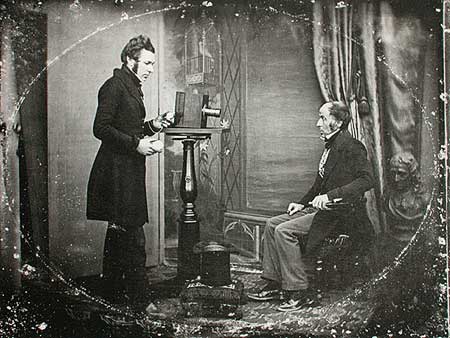
©Copyright 1995-2016

Sir Jabez Hogg (left) taking a photograph of an unknown subject
The manifold uses and advantages of the Microscope crowd upon us in such profusion that we can only attempt to enumerate them in the briefest and most rapid manner...It is not many years since this invaluable instrument was regarded in the light of a costly toy; it is now the inseparable companion of...science. In the medical world, its utility and necessity are fully appreciated...knowledge which could not be obtained even by the minutest dissection is acquired readily by its assistance, which has become as essential to the anatomist and the pathologist as the scalpel and bedside observation. The smallest portion of a diseased structure, placed under a Microscope, will tell more in one minute...than could be ascertained by long examination of...disease in the ordinary method.
—Jabez Hogg, F.L.S., F.R.M.S. The
Microscope: Its History, Construction, and Application: Being a Familiar Introduction
to the Use of the Instrument, and the Study of Microscopical Science (First Edition, 1854)
"Electronic textbooks" are the wave of the future in education. Five paper-based versions of this manual were produced between 1987 and 1994, derived from much earlier notes made up in the early 1980's. The first version for the World Wide Web was made available in 1995.
Every revision since has added additional illustrations and accompanying text, but I make no pretense that this CD is comprehensive or complete. Just exactly what constitutes "complete" is a matter of opinion. I never suspected when I started this project that it would come to dominate my professional activities, and indeed my post-retirement ones. I suppose it will never be "completed" because I'll always be dissatisfied with something in it, or find some new image that just has to be included. So perhaps the best way to say it is that previous versions have been revised to make this one....which is and will remain a work in progress.
What I have created is intended as a manual to be used as a supplement to a good textbook. I taught the subject in veterinary schools, but the material has utility to anyone interested in histology, because in the microscope, everyone looks alike. What started originally as a set of short notes has become a fair-sized book, thanks in large measure to the thousands of DVM and MD students I've had the pleasure of teaching. Their willingness to provide comments and suggestions for improvements, and their frank and open criticism of its flaws (sometimes a little too frank for my author's vanity to be happy about) have improved it immeasurably, and I hope that anyone who uses it will feel free to make any further suggestions that might occur to them. Past experience assures me they will.
In writing these exercises, I've given free rein to my natural tendency to garrulousness. I suppose they're just a teensy bit wordier than is absolutely necessary, but so what? I had fun writing them, and I'm the kind of person who never uses one word where six will do. There are a lot of asides and footnotes in here not because they're all that important but because I thought they were interesting in context. The life sciences are a continuum, and the scientists of the past are as important to us as those of the present day, so I have thrown in a lot of names and dates. Modern medicine is built on the foundations they laid down. Most of the structures described and shown here were discovered between 1850 and 1950, and represented new and exciting discoveries in their time; they are no less exciting because they aren't new anymore.
Sir Isaac Newton once remarked that "If I have seen farther than other men, it is because I have stood on the shoulders of giants," and it's my belief that great scientists like Purkinje and Golgi and their contemporaries were giants who should be remembered and honored.
Blacksburg, Virginia, Christmas Day, 2015